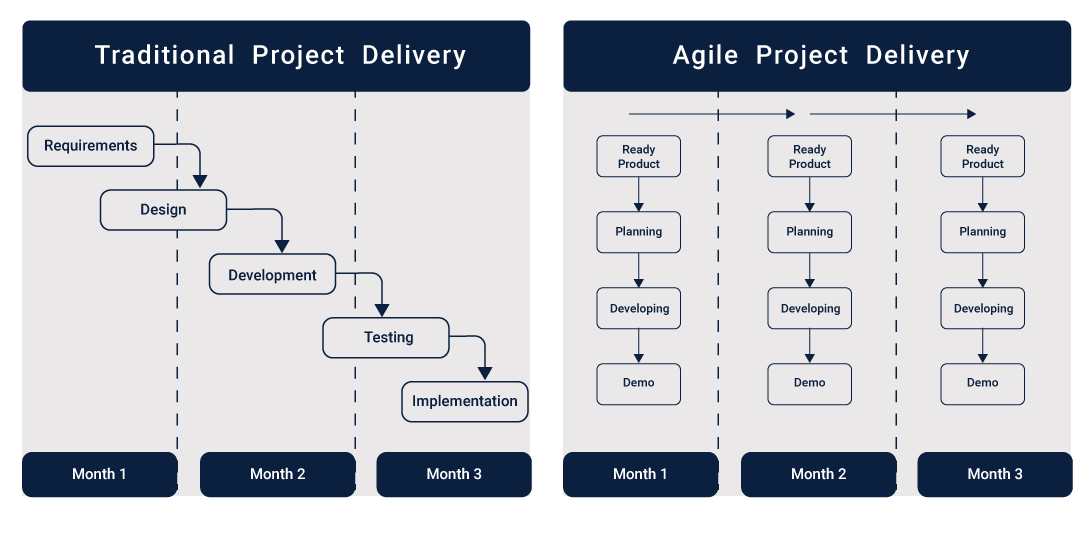As technology continues to grow by leaps and bounds, speed and flexibility have become vital when it comes to meeting client deliverables. Traditional project management strategies like the waterfall method, while extremely accurate and disciplined, do not support adaptability and encourage feedback.
But with the Agile development strategy, organizations across various industries have succeeded in revolutionizing the way their projects are managed. Companies with software as their core business have particularly benefited from the Agile way. However, along with the growing popularity of Agile software development, there is another trend that is fast catching up, and for good reasons – software outsourcing.
What Happens When Agile Development Meets Software Outsourcing?
Businesses have woken up to the advantages of outsourcing their processes to third-party service providers. When companies outsource software development or product development, they stand to gain in more ways than one. Reduced long-term costs, better accuracy and efficiency, and improved competitive advantage are just some of them.

The two practices may seem to be entirely different from one another, with no overlapping concepts whatsoever. But let’s take a step back and delve a little bit into what forms the heart of agile development.
The Agile method prioritizes customer satisfaction and seeks to achieve this goal through early and continuous deliver of software or solutions. Typically, practices like Scrum, DevOps, Crystal, and Extreme Programming are used to implement the Agile technique. And while the ways may be many, the central principle focuses on flexibility as opposed to a strict, laid out plan. For this, it’s important to have a dedicated, cross-functional team that handles the project.
When businesses outsource, it can be a challenge to continue to follow the Agile way. A number of factors contribute to this problem. In the section that follows, we’ve discussed the challenges that may crop up when companies tend to outsource software development and seek to follow the Agile development strategy simultaneously.
Despite these challenges, it’s not impossible to make agile development work when you outsource software development. There are several ways to work around these roadblocks, as we’ll see here.
Implementing Agile in Tandem with Outsourcing : Challenges and Solutions
Up until recently, many experts believed that outsourcing was only feasible with project management techniques that were based on the Waterfall method. However, the Agile method’s increasing popularity has birthed the question – Will Agile development work if you outsource software development? Some say it does, and some don’t agree.
What gets in the way of implementing the Agile way when you outsource product development or software development, and how can it be tackled? Let’s break it down one by one.
Challenge 1: Lack of Prior Experience in the Agile Technique
Most IT outsourcing companies that provide outsourcing services are built on a framework that follows a rigid set of principles that takes them from one phase to the next. This setup is essentially the Waterfall system. One of the primary challenges that you’ll face when you’re interested in being Agile even when you’re outsourcing your software development is finding a partner who can support your processes.
The Solution: Find an Agile Service Provider
They say that necessity is the mother of invention. And true enough, as the demand for agile IT outsourcing companies grows, several service providers are embracing this technique. To continue to remain Agile, the logical point to start would be to find a third-party service provider who understands the mechanics of the Agile method. But don’t stop there. Make sure they have adequate experience in this area before partnering with them.
Challenge 2: Ineffective Communication
The Agile process relies heavily on open, constant communication. Unfortunately, when you outsource your requirements to a contractor, your communication process gets a wee bit more difficult. Additionally, since face-to-face communication is encouraged in the Agile method, it can be challenging to keep in-person channels of communication open.
The Solution: Actively Encourage Communication
There’s no shortcut to tackling this challenge. The most effective way to overcome breaks in communication with your their-party service provider is to actively strive to keep the channels of communication open and functioning. Email is one of the most efficient ways to go about this. Additionally, you can supplement it with other forms of communication like video conferencing. And most importantly, arrange for a few team-visits each year so the offshore development team can connect better with your emails.
Challenge 3: Lack of Team Structure
The Agile methodology sets a lot of store by teamwork. Cross-functional teams that work together to deliver the results to the end customer are extremely vital to the success of the Agile way. However, many companies tend to outsource their software development processes to individual professionals. This can come in the way of the Agile method because it is not possible for an individual, no matter how skilled, to function with the same collaboration that’s found in a team.
The Solution: Focus on Teams Instead of Individuals
The presence of one skilled expert may not be the best reason to choose a particular team. This is because if the team as a whole cannot match up to the requirements of your project, the Agile method will crumble. So, before you sign the deal with a third-party service provider, evaluate their teams and verify how well they fit into the Agile framework. Focusing on teams rather than on individuals can help you build a network that can allow you to remain agile.
Challenge 4: Rigidity vs. Flexibility
No discussion about outsourcing while following the Agile way is complete without mentioning the flexibility that Agile techniques require. On the other hand, most outsourcing service providers follow a rigid process flow that’s pretty much set in stone. How, then, do you strike the balance between outsourcing your processes and remaining loyal to the Agile method? The answer is simple – shift the focus.
The Solution: Redesign Your Contracts to Support Flexibility
Your contract with your service provider forms the basis of the outsourcing operation. Naturally, it follows that if you want to redo the way things are being done, you need to redefine how you draw out your contract. Lay more emphasis on flexibility of certain aspects. Be open to the idea that your processes may change as the project progresses, as will your ideas, expectations, and requirements. Making room for these variables can help you adhere to the Agile method even if you have a third-party service provider handling your project.
A Final Word
Ultimately, it all comes down to finding a partner that not only understands the Agile method, but also has the DNA to do things that way. At Cuelogic, Agile is culture and a natural way of doing things.
We strive to get you the results you need and maximize value for your processes without deviating from the Agile method. With great emphasis on open communication, flexibility, and efficient teamwork, our project management techniques will allow you to remain Agile even when you outsource software development.
